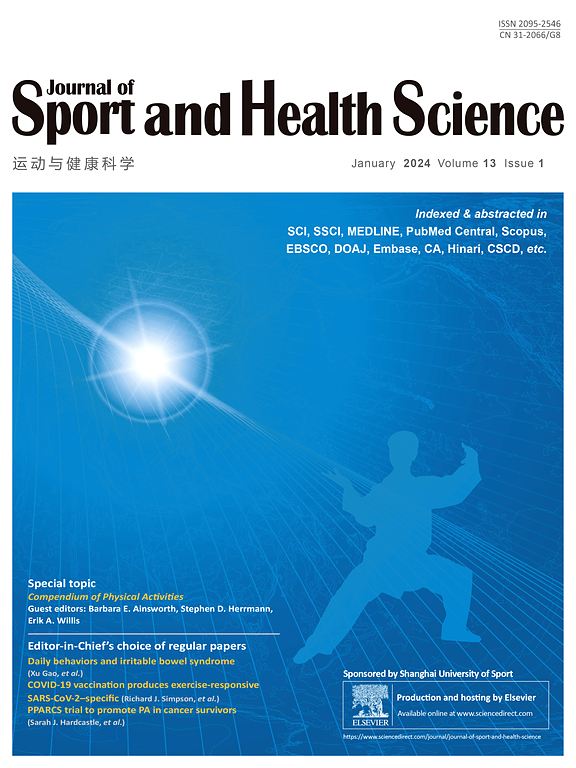Exercise training-induced extracellular miR-136-3p modulates glucose uptake and myogenesis through targeting of NRDC in human skeletal muscle.
IF 10.3
1区 医学
Q1 HOSPITALITY, LEISURE, SPORT & TOURISM
引用次数: 0
Abstract
BACKGROUND Regular physical training induces adaptive effects across multiple organ systems, highlighting the existence of inter-organ communication networks. However, the molecular mechanisms underlying both exercise-induced adaptations and organ-to-organ signaling are not fully characterized. Circulating extracellular vesicles (EVs), including exosomes, carry molecules like microRNAs (miRNAs) that may mediate tissue crosstalk. This study aimed to identify specific exercise training-responsive miRNAs that affect skeletal muscle function. METHODS miRNA expression profiles of serum-derived EVs were analyzed in healthy young individuals before and after 3 weeks endurance exercise training. Exercise training-responsive miRNAs were then validated for a functional role in cellular metabolic processes in human myotubes. RESULTS We identified several exercise training-responsive miRNAs within exosome-rich EVs in serum, including miR-136-3p. In human myotubes, miR-136-3p enhanced glucose uptake and targeted the nardilysin convertase (NRDC) gene. Transfection of miR-136-3p or silencing of NRDC induced a shift towards glycolytic metabolism in mitochondria and modulated gene expressions related to myogenesis. Pancreatic islets were identified as a potential source of miR-136-3p based on in silico analysis of gene expression and a molecular analysis of conditioned media from isolated pancreatic islets. CONCLUSION MiR-136-3p is an endurance training-responsive molecular transducer that modulates glucose metabolism and cellular proliferation in myocytes. Associated with EVs, extracellular miR-136-3p may serve as a molecular messenger to communicate islet-skeletal muscle crosstalk after exercise. Extracellular miR-136-3p may serve as a molecular messenger to communicate islet-skeletal muscle crosstalk. Our results highlight a miRNA-mediated mechanism that participates in inter-organ communication to fine tune the metabolic adaptations to exercise.运动训练诱导的细胞外miR-136-3p通过靶向人骨骼肌中的NRDC调节葡萄糖摄取和肌肉发生。
有规律的体育锻炼会引起多个器官系统的自适应效应,突出了器官间通信网络的存在。然而,运动诱导的适应性和器官-器官信号传导的分子机制尚未完全确定。循环细胞外囊泡(EVs),包括外泌体,携带可能介导组织串扰的分子,如microrna (mirna)。本研究旨在确定影响骨骼肌功能的特定运动训练反应性mirna。方法分析健康青年3周耐力运动训练前后血清源性ev的smirna表达谱。然后验证了运动训练反应性mirna在人肌管细胞代谢过程中的功能作用。结果:我们在血清中富含外泌体的ev中鉴定了几种运动训练反应性mirna,包括miR-136-3p。在人肌管中,miR-136-3p增强葡萄糖摄取并靶向溶糖素转化酶(NRDC)基因。转染miR-136-3p或沉默NRDC诱导线粒体向糖酵解代谢转变,并调节与肌生成相关的基因表达。基于基因表达的计算机分析和分离胰岛条件培养基的分子分析,胰岛被确定为miR-136-3p的潜在来源。结论mir -136-3p是一种耐力训练反应性分子传感器,可调节肌细胞的糖代谢和细胞增殖。与ev相关,细胞外miR-136-3p可能作为运动后胰岛-骨骼肌串扰的分子信使。细胞外miR-136-3p可能作为分子信使传递胰岛-骨骼肌串扰。我们的研究结果强调了一种mirna介导的机制,该机制参与了器官间的交流,以微调代谢适应运动。
本文章由计算机程序翻译,如有差异,请以英文原文为准。
求助全文
约1分钟内获得全文
求助全文
来源期刊

Journal of Sport and Health Science
SPORT SCIENCES-
CiteScore
18.30
自引率
1.70%
发文量
101
审稿时长
22 weeks
期刊介绍:
The Journal of Sport and Health Science (JSHS) is an international, multidisciplinary journal that aims to advance the fields of sport, exercise, physical activity, and health sciences. Published by Elsevier B.V. on behalf of Shanghai University of Sport, JSHS is dedicated to promoting original and impactful research, as well as topical reviews, editorials, opinions, and commentary papers.
With a focus on physical and mental health, injury and disease prevention, traditional Chinese exercise, and human performance, JSHS offers a platform for scholars and researchers to share their findings and contribute to the advancement of these fields. Our journal is peer-reviewed, ensuring that all published works meet the highest academic standards.
Supported by a carefully selected international editorial board, JSHS upholds impeccable integrity and provides an efficient publication platform. We invite submissions from scholars and researchers worldwide, and we are committed to disseminating insightful and influential research in the field of sport and health science.
 求助内容:
求助内容: 应助结果提醒方式:
应助结果提醒方式:


